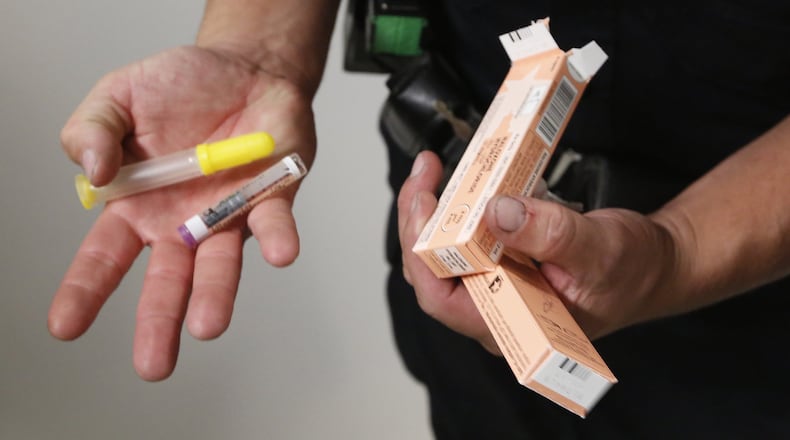Cecilie McGhehey serves as project director for the grant work and told City Council in a July 19 work session the effort is in three phases – building connections, building capacity and care delivery. That third phase will begin September 1.
The presentation to Council centered around harm reduction efforts aimed at helping those wanting help to escape their addictions. Some individuals need help with substance abuse or misuse or with mental health and addiction issues.
“Some people need both,” she said in an interview two weeks prior to that Council meeting.
The million-dollar grant was awarded to the Butler County Mental Health and Addiction Services Board as the agent for the consortium, which includes the Talawanda School District, Miami University, McCullough-Hyde Memorial Hospital/TriHealth, the Coalition for a Healthy Community – Oxford Area, Epiphany Community Services and The Butler County MHARS board.
The money is intended to address prevention, treatment and recovery activities to support the Oxford community.
The grant comes from the federal Rural Communities Opioid Response – Implementation program through the Health Resources and Services Administration, a division of the U.S. Department of Health and Human Services. The grant is intended to support prevention, treatment and recovery services within the Oxford Area, specifically, the Talawanda School District, through The Oxford Area Addiction Response Initiative.
Discussion at the July 19 work session of City Council focused on Syringe Services Programs to stem the growing tide of blood-borne pathogens among those sharing or reusing needles.
A study by the Centers for Disease Control and Addiction found that users of SSPs were three times more likely to stop injecting drugs.
Jordan Meyer, an epidemiologist with the Butler County General Health District, spoke at the Council work session offering several slides showing numbers of cases, hospitalizations and deaths from drug use.
“Fentanyl is the drug most likely to lead to death,” Meyer said while a chart being shown on the screen listed 10 drugs or drug categories leading to overdose fatalities for 2020 and 2021. Fentanyl-related deaths in Butler County for 2020 totaled 155 and there only four fewer in 2021. That was the only drug in either year responsible for more than 66 deaths and many were in single digits.
McGhehey said one important piece of their harm reduction efforts is a weekly visit with a van in the parking lot of the DuBois warehouse on College Corner Pike offering support for those in need, but she emphasized they do not offer a syringe program since there are many requirements in setting that up. The harm reduction site is in place every Wednesday from 11 a.m. to 1 p.m.
That service offers Narcan to make it available and she said it explains how to use it on the box; training is no longer needed to administer it. They can also provide wound care because users will sometimes develop lesions.
She told City Council one of their goals in Phase 3 will be to find a brick and mortar location for their complete harm reduction work and they hope the city can identify accessible building options to help providers reduce the stigma of substance use care. She said the goal of complete harm reduction is meeting people where they are.
Daryl Hams, project director for the Regional Harm Reduction Collaborative, was also on hand at the Council work session and told Council members they were asking for the city to read a draft of a letter they had provided supporting the work they want to do. City Manager Doug Elliott said he would share it with the law director to review it.
Council Member Amber Franklin said the discussion was timely because of the recent opioid settlement which will bring in some funds through the state as part of the settlement with pharmaceutical companies.
Police Chief John Jones said he was part of some of the meetings when these topics were discussed and said he had expressed concern about the possibility of Hamilton residents coming here to take advantage of the harm reduction efforts but then stopping to buy drugs in town.
Hams said that is not likely to happen.
“Data show people do not want to stick around,” he said.
Vice Mayor Chantel Raghu said this program is an important one because studies have shown incarceration of offenders has a greater annual cost than providing treatment.
The HRSA grant program is part of a Rural Communities Opioid Response Program. Oxford is designated as rural based on the 45056 Zip Code. McGhehey said Preble County is designated as rural but Somerville is not designated rural but can be served under the grant program because it is within the Talawanda School District. Because of that, they are able to reach more individuals without going against what the HRSA has designated.
“We are still trying to reach families. There is a lot of need outside of Oxford,” she said.
Others on hand for the Council work session were Tyrina Smith, Harm Reduction Coordinator for the Butler County General Health District; Joanna Lowry, Butler County Mental Health and Addiction Recovery Services Board; and Amy Macechko, of the Coalition for a Healthy Community - Oxford area.
About the Author
